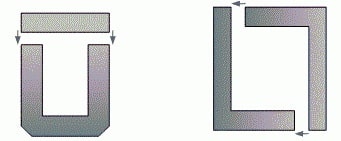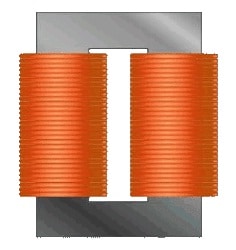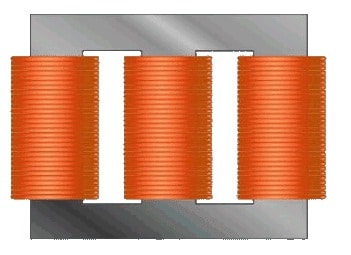A transformer is a voltage control device used to step up and step down the voltage in various electrical circuits. The working principle of a transformer is electromagnetic induction & mutual induction. These are classified into two types like core type and shell type. In core type transformer, the magnetic core mainly contains two limbs and two yokes whereas shell type transformer contains three limbs & two yokes. So the main difference between these two transformers is the core and wiring arrangement within the transformer design. So this article discusses an overview of a core type transformer – working with applications.
What is Core Type Transformer?
A type of transformer that has a magnetic core and two windings around the core like primary & secondary is known as a core type transformer. In the transformer, the core is a significant part that provides a magnetic path continuously for a minimum air gap. The core type transformer diagram is shown below.

Core Type Transformer
Core Type Transformer Construction
The core type transformer mainly includes three parts core, the primary winding, and the secondary winding. The core in this transformer is designed with a laminated steel sheet that has high silicon content, less hysteresis loss & high permeability. The steel sheet is laminated with an oxide layer over the surface or with a light coat of core-plate varnish. Here, the lamination width mainly changes from 0.35 mm for 50 Hz frequency to 0.5 mm for 25 Hz. Frequency.

Core Type Transformer Construction
The two windings in this transformer surround a significant part of the core. Usually, the transformer’s core is rectangular in shape whereas the windings are circular and are arranged on the opposite limbs of the transformer’s core. In large core type transformers, circular or round-shaped cylindrical coils are utilized because the circular cylindrical coils have high mechanical power.
The working principle of a core type transformer is to transmit power from one source to another through electromagnetic induction. These are magnetic material pieces that have a high magnetic permeability used to guide magnetic fields within transformers.
Laminations
The core type transformer uses various types of lamination because the shape of the required core is simply formed when L-L & U-I stamping lamination are associated together. Based on the transformer rating, the shape of the transformer core is selected. The winding used for a small rating transformer is rectangular or square in shape where this type of transformer includes less current carrying capacity conductors & it is simple to enfold the conductor within a rectangular or square shape. For the small rated transformer, the rectangular or square type core is economic.
For a transformer with a large rating, the thick winding conductor is utilized for carrying more current. It is not easy to twist the thick conductor within a square or rectangular shape.

L-L and U-I Laminations
The best choice in view of optimizing the utilization of copper conductors for this transformer is the round cylindrical-shaped winding. Once this winding is used on a square cross-sectional core limb, a significant gap between the core & winding is not used. This not-used space is reduced by the stepped cross-sectional core. To shape an almost circular cross-sectional core, the lamination in different shapes is staged. So, the cross-section of the core might be 1-stepped, 2- stepped, (or) multi-stepped.
Core Type Transformer Types
Core type transformers are classified into two types single phase and three-phase transformers.
Single Phase
This type of core transformer uses single phase AC voltage & provides single phase AC voltage based on the transformer’s turns ratio. In this transformer, the magnetic circuit includes two limbs or vertical legs with two yokes or horizontal sections. In this transformer, half of every winding is arranged on every leg of the core to reduce the leakage flux.

Single Phase Core Transformer
The winding with low voltage is arranged next to the core whereas the winding with high voltage is arranged around the less voltage winding to decrease the necessity of insulating material. So, the two windings are located as concentric coils. Such type of winding is known as cylindrical/ concentric winding.
Three Phase
This type of transformer uses three-phase AC voltage based on the turn ratio of the transformer. This transformer is most appropriate for transmission & distribution purposes. The core in this kind of transformer is made up of three legs/ limbs & two yokes. The magnetic path is created in between these 2 yokes and 3 limbs. So, on every limb, both the windings are concentrically wounded. The windings used for this transformer are circular cylindrical coils.

Three Phase Core Transformer
The windings of a single phase are wounded on a single leg. In a balanced state, the magnetic flux within every phase of the limb adds up to zero. So, in normal conditions, no return limb is required. However, in unbalanced loads cases, and high circulating current supplies & thus it may be best to utilize 3-single phase transformers.
Merits and Demerits
The merits of a core type transformer include the following.
- These transformers are robust.
- The lamination stacking within the core decreases iron loss.
- It is suitable for high-frequency applications.
- Mechanical strength is good.
- Iron losses & condensed flux prevention.
- Maintaining heavy insulation is very cheaper & efficient.
- Appropriate for High Frequencies
The demerits of core-type transformers include the following.
- These transformers are not suitable for the outdoors.
- It generates audible noise because of the magnetostriction power within the core.
- In this type of transformer, all the generated flux within the primary winding does not connect to the secondary winding and some parts of the flux also do not link. So, the flux leakage within this transformer is more.
Applications
The applications of core-type transformers include the following.
- These transformers are suitable for high-voltage range applications like power, distribution & auto transformers because high voltage simply corresponds to high flux. Thus, a thicker core is used to maintain iron loss down, so this transformer is a good choice.
- These transformers are used in electrical energy transmission and primary distribution.
- This transformer is normally used to make an overlapping joint by an additional pair of laminations that avoids iron loss & condensed flux leakage.
- This transformer is very efficient for high frequencies because it uses numerous steel laminations where laminations are protected through a non-conducting insulation material in between layers.
- This transformer is also used to step up and step down the voltage.
Know more about Single Phase Transformer MCQs , Laplace transform MCQs.
Know more about Step Down Transformer.
Please refer to this link for Z-transform MCQs, Core Transformer MCQs.
Thus, this is all about an overview of a core type transformer – working with applications. This transformer utilizes concentric cylindrical winding whereas the shell type utilizes sandwiched winding. The winding in this transformer simply surrounds the core whereas the core surrounds the winding in a shell type transformer. Here is a question for you, what is a shell-type transformer?